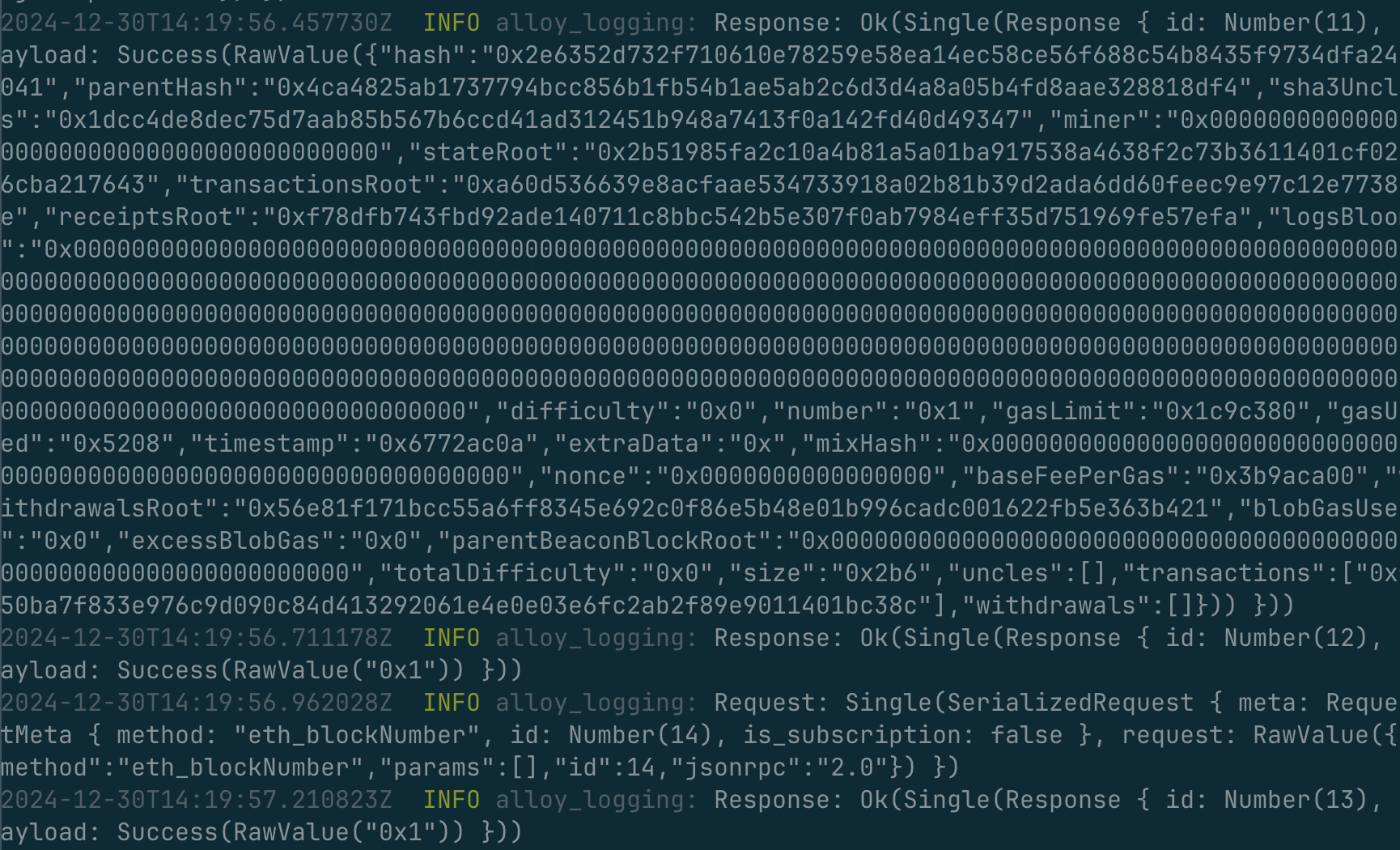Customizing RPC Communication with Alloy's Layers
In the previous guide, we covered Alloy fillers. This time we'll discuss how to use Alloy layers to customize HTTP-related aspects of RPC client communication.
Layers 101
To better understand layers, we first have to explore the Tower crate. It's a basic building block for many popular Rust tools, including Reqwest, Hyper, Axum, and, of course, Alloy.
What all these crates have in common is that they work with HTTP request/response communication. That's where Tower comes into play. It's an opinionated framework for constructing pipelines for Request -> Response transformations. Tower also comes with a set of built-in layers that add functionality like rate limiting, compression, retry logic, logging, etc.
Check out this classic blog post for a more in-depth explanation of the origins of the Tower Service trait. To better understand Service and Layer traits, let's implement a barebones Request/Response processing pipeline using Tower.
Basic tower service and layer implementation
For the sake of simplicity, we're implementing a basic tower service that prepends a "Hello " to the incoming request message.
A custom DelayLayer will be added to this service using the ServiceBuilder.
Here's the implementation of our DelayLayer:
struct DelayLayer {
delay: Duration,
}
impl DelayLayer {
fn new(delay: Duration) -> Self {
Self { delay }
}
}
impl<S> Layer<S> for DelayLayer {
type Service = DelayService<S>;
fn layer(&self, service: S) -> Self::Service {
DelayService {
service,
delay: self.delay,
}
}
}
struct DelayService<S> {
service: S,
delay: Duration,
}
impl<S, Request> Service<Request> for DelayService<S>
where
S: Service<Request> + Send,
S::Future: Send + 'static,
{
type Response = S::Response;
type Error = S::Error;
type Future = BoxFuture<'static, Result<Self::Response, Self::Error>>;
fn poll_ready(&mut self, cx: &mut Context<'_>) -> Poll<Result<(), Self::Error>> {
self.service.poll_ready(cx)
}
fn call(&mut self, req: Request) -> Self::Future {
let delay = self.delay;
let future = self.service.call(req);
Box::pin(async move {
sleep(delay).await;
future.await
})
}
}It's a bit verbose for its minimal functionality. Please refer to the inventing the service layer post to understand the origin of this boilerplate better.
The core functionality of our layer is implemented in the call method. You can see that it wraps the unresolved future and delays it by calling sleep. This implementation is similar to how we can modify the alloy Request/Response cycle. It's worth noting that the DelayLayer is generic over the Service allowing composibilty/layering with other services.
Here's our DelayLayer being added added to a basic tower service:
#[tokio::main]
async fn main() {
let mut service = ServiceBuilder::new()
.layer(DelayLayer::new(Duration::from_secs(5)))
.service(MyService);
let response = service.call("Alice".to_string()).await;
match response {
Ok(msg) => println!("{}", msg),
Err(_) => eprintln!("An error occurred!"),
}
}Running this example outputs "Hello Alice!" after a 5-second delay.
Layers might sound similar to the fillers, but there's a crucial difference. Fillers can be used to modify the TransactionRequest object before it is submitted. Layers work within the Request/Response scope, allowing us to customize logic before and after sending the RPC request. If you're familiar with the Alloy predecessor Ethers.rs, you've probably noticed that it used middleware to achieve the same result.
How to use layers in Alloy
Now that we've covered the basics let's see how layers fit within the Alloy stack. In this context, a Service is the Alloy Provider, and we can tweak how it sends RPC requests and handles responses.
Let's start with a simple example of reusing our DelayLayer for Alloy providers. This particular example does not have the best practical use case, but it shows that some generic layers can be reused regardless of the underlying Service Request type:
#[tokio::main]
async fn main() -> Result<()> {
let anvil = Anvil::new().try_spawn()?;
let signer: PrivateKeySigner = anvil.keys()[0].clone().into();
let client = ClientBuilder::default()
.layer(DelayLayer::new(Duration::from_secs(1)))
.http(anvil.endpoint().parse()?);
let provider = ProviderBuilder::new()
.wallet(signer)
.connect_client(client);
let bob = Address::from([0x42; 20]);
let tx = TransactionRequest::default()
.with_to(bob)
.with_value(U256::from(1));
let bob_balance_before = provider.get_balance(bob).await?;
_ = provider.send_transaction(tx).await?.get_receipt().await?;
let bob_balance_after = provider.get_balance(bob).await?;
println!(
"Balance before: {}\nBalance after: {}",
bob_balance_before, bob_balance_after
);
Ok(())
}Running this example would output:
# After a 1 second delay
Balance before: 0
Balance after: 1You'll notice a considerable delay before it executes. Let's add logging to better understand where it's coming from.
Using logging layer for Alloy provider
struct LoggingLayer;
impl<S> Layer<S> for LoggingLayer {
type Service = LoggingService<S>;
fn layer(&self, inner: S) -> Self::Service {
LoggingService { inner }
}
}
#[derive(Debug, Clone)]
struct LoggingService<S> {
inner: S,
}
impl<S> Service<RequestPacket> for LoggingService<S>
where
S: Service<RequestPacket, Response = ResponsePacket, Error = TransportError>,
S::Future: Send + 'static,
S::Response: Send + 'static + Debug,
S::Error: Send + 'static + Debug,
{
type Response = S::Response;
type Error = S::Error;
type Future = Pin<Box<dyn Future<Output = Result<Self::Response, Self::Error>> + Send>>;
fn poll_ready(&mut self, cx: &mut Context<'_>) -> Poll<Result<(), Self::Error>> {
self.inner.poll_ready(cx)
}
fn call(&mut self, req: RequestPacket) -> Self::Future {
println!("Request: {req:?}");
let fut = self.inner.call(req);
Box::pin(async move {
let res = fut.await;
println!("Response: {res:?}");
res
})
}
}You can notice that it's very similar to the DelayLayer. Core logic lives in the call method, and instead of delaying requests with sleep, we use tracing::info! calls to log them.
Here's how you can connect it to the provider:
// Request/Response modifying layers should be added to the RPC-client
let client = ClientBuilder::default()
.layer(DelayLayer::new(Duration::from_secs(1)))
.layer(LoggingLayer)
// Previously, on_http
.connect_http(anvil.endpoint().parse()?);
let provider = ProviderBuilder::new()
.wallet(signer)
.connect_client(client);
You can see that our simple example triggered various RPC requests: eth_blockNumber, eth_getBlockByNumber, eth_chainId, eth_transactionCount, eth_getBalance, and more.
Thanks to the custom layer we can fine-tune the LoggingLayer policy and for example only log RPC calls sending transactions:
fn call(&mut self, req: RequestPacket) -> Self::Future {
if let RequestPacket::Single(req) = &req {
if req.method() == "eth_sendTransaction" || req.method() == "eth_sendRawTransaction" {
tracing::info!("Request: {req:?}");
};
}
let fut = self.inner.call(req);
Box::pin(fut)
}Running this reworked example produces a much cleaner output:

You can see that layers provide powerful low-level control over how the provider handles RPC calls.
Summary
Alloy layers combined with fillers allow for elaborate customization of transaction dispatch logic. Mastering these APIs could save you a lot of manual tweaking and enable building robust provider pipelines fine-tuned to your application requirements.
